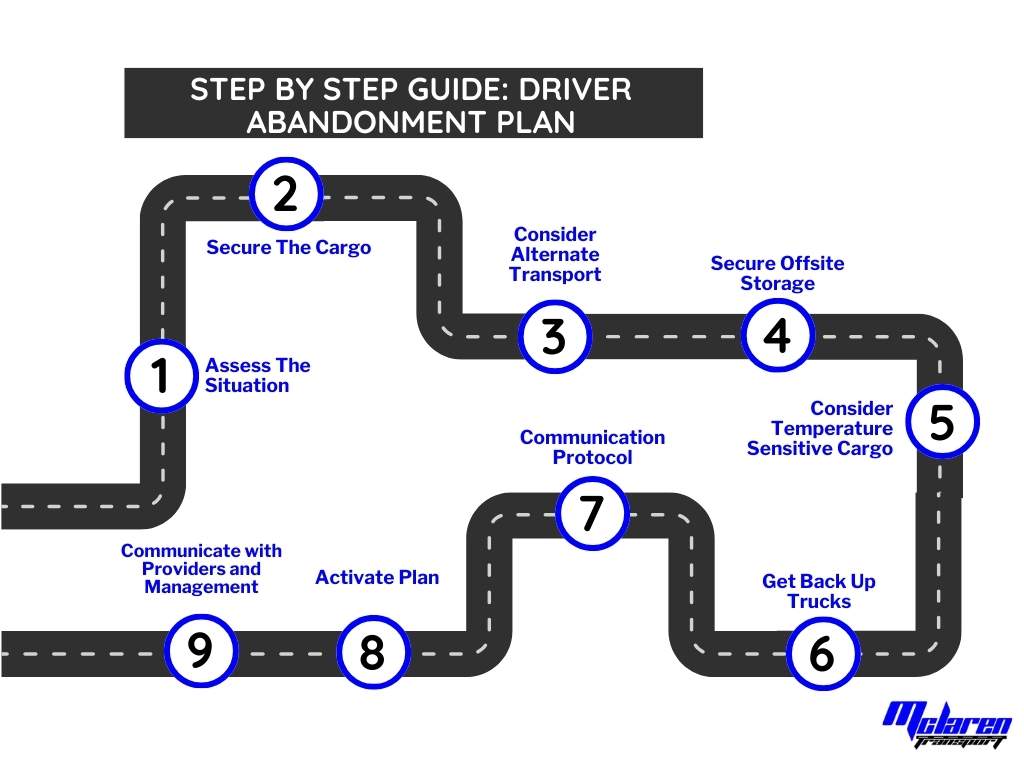A Guide for Medium-Sized Trucking Companies
In the business of cargo, freight and logistics, unexpected challenges often emerge, demanding immediate attention and strategic responses. Addressing complex scenarios such as driver abandonment becomes paramount for maintaining operational efficiency and ensuring the timely delivery of cargo. This 10-step guide provides a comprehensive and strategic approach to resolving this urgent issue that often requires immediate attention. Believe it or not, driver abandonment happens more often than you think. Let’s explore the 10-step guide.

1. Immediate Assessment of the Situation:
As a medium-sized trucking company or even larger, understanding the importance of a swift and thorough assessment when confronted with the unexpected event of cargo abandonment is crucial. This initial step is vital in evaluating the circumstances, pinpointing the location of the cargo, and understanding the reasons behind the abandonment. Understanding the reasons behind the abandonment can help your company make some organizational changes to avoid this situation. Most importantly, you want to then consider transportation clients in mind and head to the next step of this guide.
2. Secure the Abandoned Cargo:
Promptly taking action to secure the abandoned cargo is essential. Through collaboration with the driver and trusted logistics partners, companies can ensure a proactive approach to mitigate risks associated with damage, loss, or unauthorized handling during the transitional phase. Simply locate a trusted logistics partner by researching “Get trucking quote” and talk to a few companies local to the cargo location.You may also want to contact local authorities to ensure no further losses are taken. This is one of the most important steps in this guide not only to locate the cargo but also establishes a foundation for resilient logistics operations for the future.

3. Alternative Transportation Arrangements:
In the face of unexpected disruptions, exploring alternative transportation options to ensure the cargo reaches its destination on time is imperative. Proactively engaging with backup drivers or seeking the assistance of alternate carriers showcases adaptability and resourcefulness in navigating unforeseen challenges. The goal here is to ensure that the delivery happens on time – or at least with the least disruptions as possible. Logistics firms near the cargo location or even near the final destination should be explored and contacted at this point.
4. Secure Offsite Storage:
Recognizing the potential need, strategically securing offsite storage facilities becomes crucial. These facilities, that include fridge storage for perishable items, serve as a contingency plan to minimize delays in the transportation process, demonstrating a forward-thinking and prepared approach to logistics management. It particularly important for food, medication and other types of cargo.
5. Temperature-Sensitive Cargo Considerations:
For cargo with specific temperature requirements, implementing specialized measures to safeguard its integrity throughout the transportation process is paramount. If you have cargo that has been abandoned – you might want to jump to this step straight away. This approach ensures that even under challenging circumstances, companies uphold the highest standards for cargo protection and mitigate any potential losses of inventory.

6. Get Backup Trucks Ready:
Simultaneously, while assessing the situation, ensuring that backup vehicles stand ready is a proactive measure. This underscores preparedness, with standby trucks ready to seamlessly take over transportation in the event of unforeseen issues, further minimizing potential delays.
7. Communication Protocol for Delays:
Establishing a clear communication protocol for informing clients about potential delays is crucial. Transparent communication sets realistic expectations, fostering trust and understanding during unexpected situations, and reinforces commitment to client satisfaction.
8. Activate Contingency Plans:
At this point – it’s time to activate the set out plan. Recognizing the dynamic nature of the freight and logistics industry, showcasing adaptability and resilience by swiftly activating contingency plans is essential. Whether rerouting cargo, engaging backup drivers, or collaborating with alternate carriers, companies ensure minimal disruptions to ongoing operations— the ultimate goal is to get cargo back on road and to its destination on time or with the least possible delays.
9. Direct Coordination with Transport Providers:
Establishing direct communication channels with transport providers becomes imperative in this critical scenario. Ensuring immediate coordination on the delivery schedule and potential challenges, providing clear instructions on the urgency of the situation, enhances efficiency and responsiveness, crucial elements in ensuring the timely delivery of cargo.
10. Communication with Factory Management:
Maintaining transparent communication with factory management remains a cornerstone of the approach. By providing regular updates on progress and any adjustments made to ensure timely delivery, companies ensure alignment and understanding. This open line of communication with key stakeholders contributes significantly to the overall success of the logistics operation.
In conclusion, medium-sized trucking companies demonstrate their adaptability and commitment to excellence by successfully navigating the challenges of cargo abandonment. Through assessments, proactive securing measures, open communication, and apply the recommendations in this guide as quickly as possible.
Get in Touch
If you run into any challenges, consider Mclaren Transport as your logistics partner. We are located in the heart of Detroit – close to the international border into Canada.




